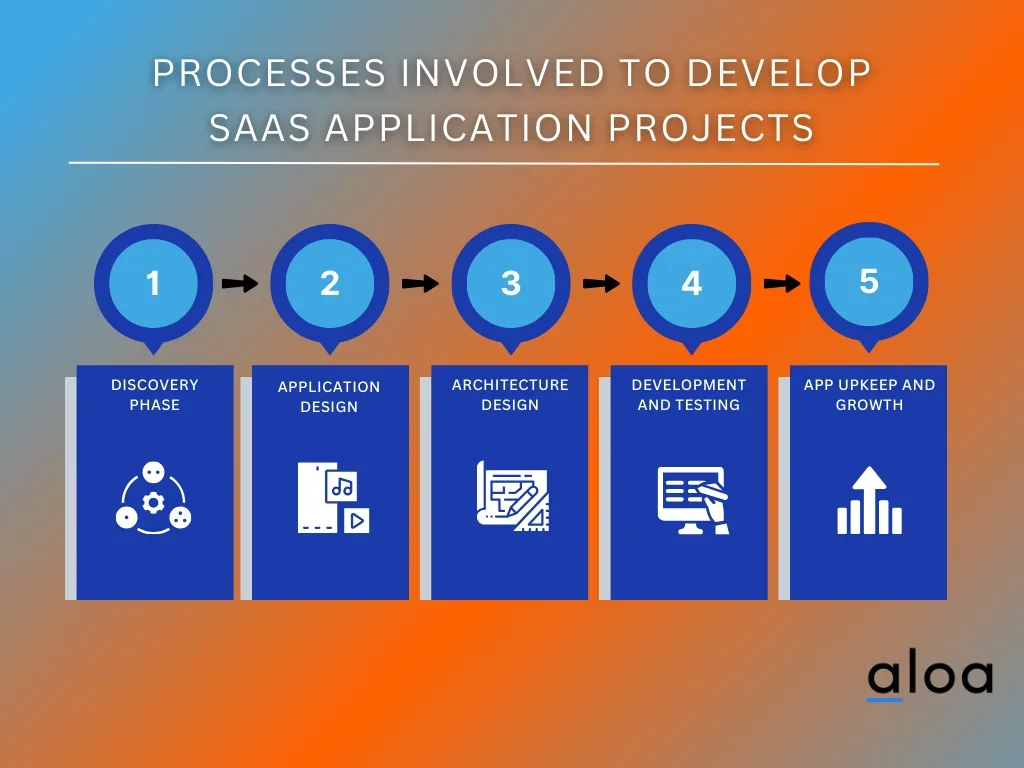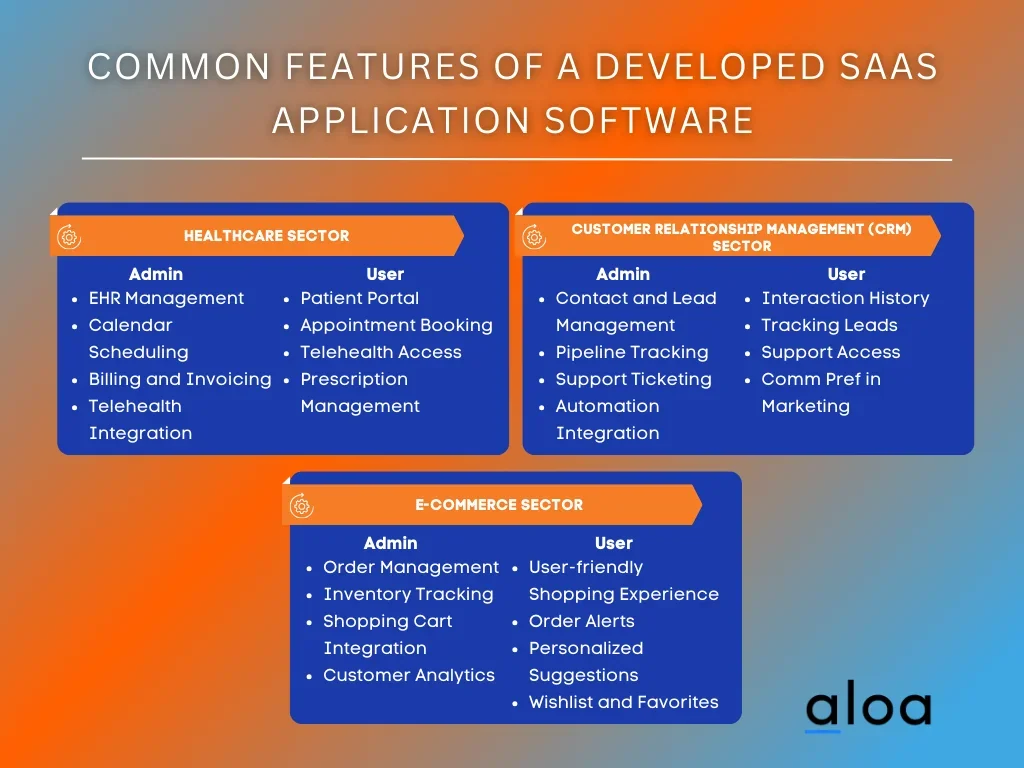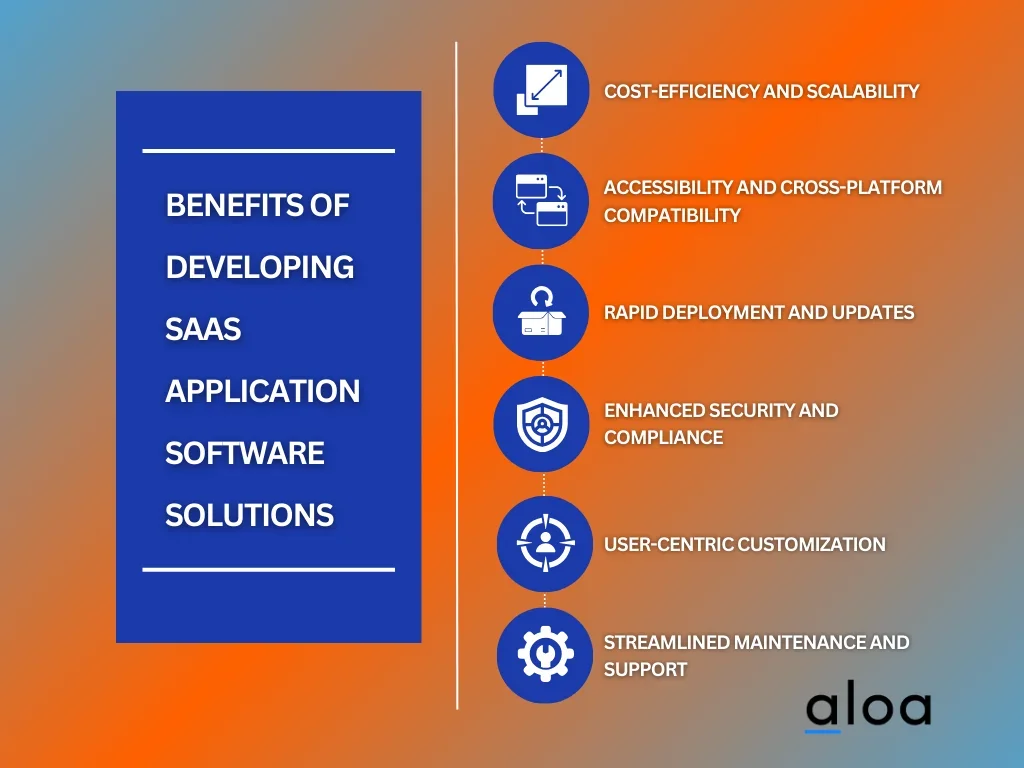In today's fast-paced digital world, to develop SaaS applications has become a cornerstone for businesses seeking growth and innovation. At the heart of this transformation lies a universal truth: successful SaaS projects are not just about cutting-edge technology; they're about understanding and adapting to the ever-evolving needs of users. This understanding forms the bedrock of every successful SaaS application, resonating with developers and business owners alike.
At Aloa, we’re leading the charge in making software development, especially when you're working with teams in different countries, much more predictable and smooth. We’re all about making the process easier, from picking the right developers to handling payments across borders. This makes things faster and saves money, making Aloa a go-to choice for finding your software development team.
In our guide, we’ll give you the lowdown on what you need to know for SaaS app development in 2024. We'll cover how to develop your SaaS application, standard features, and benefits. With Aloa's help and new ideas, you'll be all set to make great SaaS apps.
Let’s dive in!
Processes Involved to Develop SaaS Application Projects
The processes involved in developing SaaS application projects are simple and exciting. It's about blending fresh ideas with smart strategies to create something impactful. We'll walk you through this process, focusing on a clear strategy to turn your SaaS project into a success story in today's tech landscape.
Here are five core steps involved in SaaS application development:

Step 1: Discovery Phase - Meticulous Planning and Strategic Insights
The SaaS software development journey commences with meticulous planning in the discovery phase. Business analysts play a crucial role by setting up meetings to understand project details and creating essential documents such as:
- Software Requirements Documentation: Outlining features, technical specifications, and project objectives.
- Risk Assessment and Mitigation Plan: Predicting potential risks and strategizing ways to minimize them.
- Feature Breakdown List: A table containing all desired features with time estimates.
- Cost Estimate: A projected budget for SaaS application development.
During this phase, a business analyst helps define the optimal software engineering team structure, ensuring the allocated budget and timeline alignment.
Step 2: Application Design - Crafting Intuitive User Experiences
When it comes to SaaS application development, effective design goes beyond aesthetics. The User Interface (UI) and User Experience (UX) precede the application design phase. The careful consideration of the target audience's needs is paramount. A specialized UI/UX specialist enters the scene, creating designs tailored for diverse devices to ensure optimal usability across various settings. The emphasis here is not just on visual appeal but crafting an interface that resonates with the end-users, promoting seamless engagement.
Step 3: Architecture Design - Building the Foundation for Success
The backbone of any successful SaaS application lies in its software architecture. A cloud-based architecture, often leveraging platforms like Amazon Web Services (AWS), is a strategic decision guided by flexibility, scalability, and security.
With its extensive service offerings, scalability options, robust security measures, and a cost-effective pay-as-you-go model, AWS emerges as a preferred choice. The architecture design phase lays the groundwork for a resilient, adaptable, and secure SaaS application.
Step 4: Development and Testing - Iterative Progress and Quality Assurance
The development and testing phase is a dynamic combination of efforts, focusing on both the front and back end of the SaaS application. Quality assurance (QA) engineers rigorously test each functionality to ensure seamless performance.
The iterative development process often involves a Minimum Viable Product (MVP), addressing basic user needs. The Agile approach allows developers to enhance features based on real-time user feedback post-MVP launch, ensuring a user-centric and adaptive development cycle.
Step 5: App Maintenance and Further Development - Nurturing Long-Term Success
After the accessibility of the MVP to users, the development journey enters the maintenance and further development phase. This stage is characterized by a shift in focus towards performance assessment, user feedback collection, and identification of areas for improvement. SaaS developers diligently work on bug fixes and feature enhancements and stay attuned to industry trends to ensure sustained competitiveness. This phase marks the ongoing evolution of the SaaS application, adapting to user needs and technological advancements for long-term success.
Common Features of a Developed SaaS Application Software
Discovering what makes a SaaS application stand out in 2024 is key to success. In this guide, we'll highlight the must-have features that define top-tier SaaS software. From user-friendly interfaces to robust security measures, learn what it takes to build an application that resonates with today's tech-savvy users.

Healthcare Sector App Features
Admin
- Electronic Health Records (EHR) Management
- Admin Dashboard oversees patient records and healthcare data and provides a centralized hub for comprehensive data analysis.
- Role-based access control manages permissions for healthcare staff and facilitates customized access levels, ensuring data integrity.
- Appointment Scheduling and Calendar Management
- Calendar view streamlines appointment scheduling and integrates with external calendars for enhanced coordination.
- Admin tools extend beyond basic functionalities, incorporating advanced features like predictive scheduling algorithms to optimize healthcare professionals' time.
- Billing and Invoicing
- Billing dashboard evolves into a financial analytics hub, offering insights into revenue trends, expense management, and financial forecasting.
- Besides managing billing cycles, administrative controls extend to dynamic pricing structures based on patient history and treatment plans.
- Telehealth Integration
- Admin panel, in addition to managing virtual appointments, integrates AI-driven tools for real-time health assessments during telehealth consultations.
- Tools for monitoring and ensuring compliance with telehealth regulations extend to predictive analytics for optimizing telehealth services based on patient demographics.
User
- Patient Portal
- Secure login becomes a multi-factor authentication gateway, incorporating biometric authentication for heightened security.
- User-friendly interface evolves into a personalized health dashboard, offering interactive data visualizations and personalized health recommendations.
- Appointment Booking
- Intuitive appointment booking system transforms into an AI-driven scheduler, optimizing appointment slots based on historical patient preferences.
- Automated reminders and notifications evolve into personalized health tips and pre-appointment wellness recommendations.
- Telehealth Access
- User-friendly interface introduces immersive telehealth experiences with virtual waiting rooms, integrated educational resources, and real-time collaboration tools.
- Integrated chat or messaging feature transforms into a holistic patient communication platform, facilitating ongoing engagement beyond appointments.
- Prescription Management
- Access to electronic prescriptions becomes an interactive medication management system, offering medication adherence tracking and personalized dosage adjustments.
- Medication reminders and alerts expand to include AI-driven insights on potential medication interactions and side effects.
Customer Relationship Management (CRM) Sector
Admin
- Contact and Lead Management
- Admin dashboard metamorphoses into an intelligent CRM hub, leveraging machine learning to predict lead behavior and automate lead categorization.
- Tools for assigning leads transform into AI-driven lead scoring systems, optimizing lead allocation based on real-time engagement metrics.
- Sales Pipeline Tracking
- Visual representation of the sales pipeline evolves into a predictive analytics dashboard, offering actionable insights into future sales trends.
- Admin controls for analyzing conversion rates and sales performance expand to include machine learning algorithms for predicting sales cycles.
- Customer Support and Ticketing
- Admin interface becomes an integrated customer service platform, incorporating AI-driven chatbots for instant query resolution and sentiment analysis for proactive issue identification.
- Assigning tickets to support agents evolves into an intelligent ticket allocation system, optimizing agent assignment based on expertise and workload.
- Marketing Automation Integration
- Admin tools for creating and managing automated marketing campaigns evolve into a dynamic marketing orchestration platform, integrating AI for personalized content recommendations and multichannel campaign optimization.
- Integration with email marketing, lead nurturing, and analytics tools expands to include advanced predictive analytics for marketing strategy refinement.
User
- Contact Interaction History
- User access to the history of interactions with contacts evolves into a comprehensive customer journey map, offering real-time insights into customer touchpoints and preferences.
- Notes and comments section for users to add insights on contacts transforms into an AI-driven collaborative workspace, facilitating cross-team communication and insights sharing.
- Lead and Deal Tracking
- User dashboard to track leads and ongoing deals becomes an interactive analytics dashboard, offering predictive insights into deal success probabilities and personalized recommendations for deal optimization.
- Notifications for users on deal updates and milestones expand to include dynamic alerts based on real-time market trends and competitive analysis.
- Customer Support Access
- A User-friendly interface for submitting and tracking support tickets transforms into an AI-driven self-service portal, offering instant issue resolution through knowledge base integration and interactive troubleshooting guides.
- Communication tools for direct interaction with the support team evolve into an intelligent communication platform, incorporating natural language processing for sentiment analysis and proactive issue resolution suggestions.
- Marketing Communication Preferences
- User settings for managing communication preferences expand to include dynamic prediction models, anticipating user communication preferences based on historical interactions and real-time behavior.
- Opt-in and opt-out options for marketing communications evolve into a personalized communication dashboard, allowing users to customize communication frequency, content, and channel preferences.
E-commerce Sector
Admin
- Order Management
- Admin dashboard for processing and tracking orders transforms into an intelligent order fulfillment system, optimizing inventory allocation and order dispatch based on predictive analytics.
- Tools for managing order status, cancellations, and refunds evolve, including automated order status updates and dynamic refund processing based on real-time customer feedback.
- Inventory Tracking
- An inventory management system with real-time updates becomes a predictive inventory optimization platform, leveraging AI for demand forecasting and dynamic supply chain management.
- Admin controls for adding, removing, or updating product listings expand to include automated product listing updates based on market trends and competitor analysis.
- Shopping Cart Integration
- Admin interface for monitoring and analyzing shopping cart data evolves into a personalized shopping analytics platform, offering real-time insights into customer browsing behavior, cart abandonment patterns, and personalized cart recommendations.
- Tools for optimizing the checkout process and reducing cart abandonment expand to include AI-driven checkout optimization, offering personalized incentives and dynamic pricing adjustments based on user behavior.
- Customer Analytics
- Admin dashboard with insights into customer behavior and preferences becomes an intelligent customer analytics platform, offering predictive insights into future customer trends, personalized customer segmentation, and dynamic pricing strategies.
- Analytics tools for monitoring sales trends, customer demographics, and product performance have evolved to include advanced machine-learning algorithms for identifying hidden market trends, predicting product success, and optimizing marketing strategies.
User
- User-friendly Shopping Experience
- An intuitive and responsive user interface for browsing products evolves into an immersive virtual storefront experience.
- User-centric design principles ensure seamless navigation, personalized product recommendations, and a visually engaging shopping journey.
- Integrating augmented reality features allows users to try products virtually, enhancing the overall shopping experience.
- Smart cart management tools dynamically adjust in real-time, suggesting complementary items and optimizing discounts for a frictionless purchasing experience.
- Order Tracking and Notifications
- User access to order history and real-time tracking transforms into a comprehensive order management portal.
- Enhanced tracking features provide real-time location updates, estimated delivery times, and interactive options for modifying delivery preferences.
- Notifications for order confirmations, shipping updates, and delivery evolve into a personalized communication hub.
- Personalized Recommendations
- User dashboard displaying customized product recommendations expands into an AI-driven personal shopping assistant.
- Advanced machine learning algorithms analyze user behavior, purchase history, and real-time browsing patterns to provide hyper-personalized suggestions.
- The system learns and adapts to user preferences, ensuring a continually refined and relevant shopping experience.
- Wishlist and Favorites
- User tools for creating and managing wishlists evolve into an intelligent curation system.
- The wishlist becomes a dynamic repository, storing preferred items and providing insights into user preferences.
- The system actively monitors wishlist items for price fluctuations, notifying users of potential discounts or promotions.
Benefits of Developing SaaS Application Software Solutions
Developing SaaS application software is more than just a tech trend; it's a smart business move. In simple terms, we'll explore how these solutions can save costs, scale your business, and offer the flexibility and efficiency needed in today's fast-paced digital environment.
These are six core benefits of SaaS for your business.

Cost-Efficiency and Scalability
Developing SaaS applications offers a cost-effective solution compared to traditional software development models. The pay-as-you-go pricing structure allows businesses to allocate resources efficiently, paying only for the features and services they utilize.
This cost-efficiency is further enhanced by the scalability inherent in SaaS applications. As user demands grow, the system seamlessly scales to accommodate increased workloads without substantial upfront investments in hardware or infrastructure.
Accessibility and Cross-Platform Compatibility
One of the inherent advantages of SaaS application development is its accessibility. Users can access the software from any location with an internet connection, breaking down geographical barriers. Moreover, SaaS applications are designed with cross-platform compatibility in mind.
Whether accessed from a desktop, laptop, tablet, or smartphone, the user experience remains consistent. This accessibility enhances user satisfaction and facilitates collaborative work environments and remote capabilities.
Rapid Deployment and Updates
SaaS application development is a game-changer in the tech landscape. Unlike traditional software development, which may take months or even years for deployment, SaaS applications can be rolled out swiftly. This rapid deployment translates to quicker time-to-market for businesses, allowing them to stay ahead of the competition.
Furthermore, updates and enhancements are seamlessly delivered to users without causing disruptions. This continuous improvement model ensures the application remains cutting-edge and aligned with evolving industry standards.
Enhanced Security and Compliance
Security is always a concern, and SaaS application development prioritizes this aspect. With dedicated teams focused on data protection, encryption, and threat mitigation, SaaS applications are equipped to provide robust security measures.
Additionally, reputable SaaS providers adhere to industry compliance standards, ensuring the developed applications meet regulatory requirements. This commitment to security and compliance instills confidence in businesses and end-users, fostering trust in the SaaS solution.
User-Centric Customization
Developing SaaS applications empowers businesses to offer personalized and user-centric experiences. SaaS applications can tailor the interface and functionalities to individual users through user profiles, preferences, and usage patterns.
This customization not only enhances user satisfaction but also contributes to increased user adoption and engagement. Businesses can leverage analytics and user feedback to continuously refine and optimize the application for an ever-improving user experience.
Streamlined Maintenance and Support
SaaS application development shifts the service provider's infrastructure maintenance and support responsibility. This means businesses can focus their resources on core competencies while entrusting the technical aspects to experts.
The provider handles routine maintenance, updates, and troubleshooting, ensuring the application operates smoothly. This streamlined approach to maintenance translates to reduced operational burdens for businesses, allowing them to concentrate on strategic objectives and innovation.
Key Takeaway
Understanding the complexities of successfully develop SaaS application in 2024 can be overwhelming. With so many factors to consider, finding the right path can indeed be challenging.
This is where Aloa steps in as a game-changer. Our extensive experience in software development outsourcing has led us to match over 250 clients with the ideal experts for their projects. Our method? A thorough 5-step vetting process that ensures each client gets the best fit for their specific needs.
If you're starting a SaaS project and need a reliable partner to guide you through the outsourcing maze, reach out to us at [email protected]. Let Aloa be the solution to your SaaS application development challenges in 2024.

